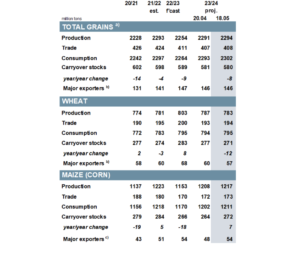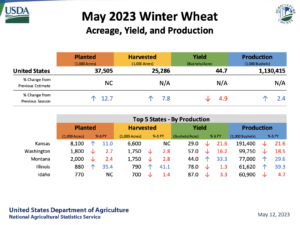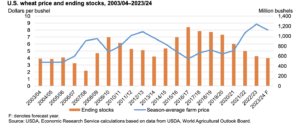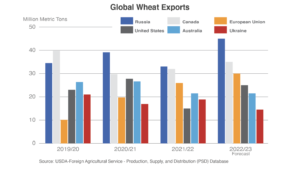Agriculture leaders in the United States House of Representatives are looking to provide at least an additional $10 billion in farmer aid to supplement the recently announced Farmer Bridge Assistance…
Global Grains Production “Forecast to Hit an All Time High,” as Drought “Is Shrinking” U.S. Winter Wheat Crop
Dow Jones writer Yusuf Khan reported yesterday that, “Global production of wheat, corn, barley and other grains is forecast to hit an all time high in the forthcoming season, as strong supplies of corn in particular drive food production to record levels.
“The International Grains Council in its May report projected that 2.294 billion metric tons of grains would be produced in the 2023-24 season. That is up from a forecast of 2.254 billion tons for the 2022-23 season, which is currently drawing to a close, and up from the record set in 2021-22 at 2.293 billion tons.

“Much of the boost in output is expected to come from higher corn production, with the 2022-23 season having seen a 2% drop on year due to droughts in Argentina and Europe. In the forthcoming season, corn production is expected to hit 1.217 billion tons, up from 1.153 billion tons in 2022-23.”
Reuters writer Nigel Hunt reported yesterday that, “The International Grains Council (IGC) on Thursday raised its forecast for 2023/24 global corn crop by 9 million tonnes to 1.217 billion tonnes largely reflecting improved outlooks for production in Brazil and China.
“The inter-governmental body, in a monthly update, raised its forecast for Brazil’s corn crop to 130.2 million tonnes, up from a previous forecast of 127 million while China’s production was raised to 279.4 million from 276.2 million.”
The Reuters article noted that, “The IGC cut its 2023/24 world wheat crop outlook by 4 million tonnes to 783 million tonnes.
“The cut was driven by a downward revision for the United States to 45.2 million from 49.4 million.
“Three years of drought have left the U.S. hard red winter wheat crop in the worst shape in memory for many farmers.
‘With an uprated maize (corn) forecast more than offsetting downgrades for wheat and barley, 2023/24 total grains production is now seen at an all-time peak,’ the IGC said.
More narrowly regarding U.S. wheat production, the USDA’s Economic Research indicated this week in its monthly Wheat Outlook report that, “U.S. wheat production for the 2023/24 marketing year is forecast at 1.66 billion bushels, up 1 percent from the previous year, but down 7 percent from the recent 5-year average of 1.788 billion bushels. USDA’s National Agricultural Statistics Service (NASS) provided its first survey-based production forecast for the 2023/24 U.S. winter wheat crop in the May 12 Crop Production report. Winter wheat production overall is projected up 2 percent to 1.130 billion bushels. Average yield is estimated at 44.7 bushels per acre, down 2.3 bushels from last year. Winter wheat area harvested is projected at 25.3 million acres, up 8 percent from last year.

“The harvested-to-planted ratio for winter wheat overall at 67 percent is the lowest since 1917.”

In related news, Bloomberg writer Michael Hirtzer reported yesterday that, “It’s so dry in Kansas that wheat plants are turning blue.
“At this time of year, crops are typically a verdant green and reach about knee height. Instead, prolonged drought means that many plants are just barely shin-high, their growth stunted by a lack of moisture. Some are yellowing, and others have the tell-tale blueish hue that plagues damaged fields.”
Hirtzer explained that, “The dryness gripping the American Plains is shrinking the US wheat harvest, limiting the expansion of world supplies and delaying further relief from the worst food inflation in decades. It also allows Russia, the biggest wheat shipper, to further tighten its hold on the global grain trade. Meanwhile the US is losing its relevance in the market, with domestic buyers even having to resort to purchases of European imports.”

Reuters News reported today that, “Wheat yield potential in Kansas was estimated at 30.0 bushels per acre (bpa) on Thursday by crop scouts on an annual Wheat Quality Council tour, the lowest since at least 2000.”
And Reuters News reported yesterday that, “Russian grain exports will total around 50-55 million tonnes in the 2023-2024 season, Agriculture Minister Dmitry Patrushev told President Vladimir Putin on Thursday.
“‘Every fifth export batch of wheat in the world is of Russian origin,’ Patrushev said. ‘We expect to deliver 50-55 million tonnes of grain to foreign partners in the new season.'”
Elsewhere, Reuters writers Nigel Hunt, Michelle Nichols reported yesterday that, “Three new ships were authorized on Thursday to take part in a deal allowing the safe Black Sea export of Ukraine grain, said the United Nations as global wheat prices fell further a day after Russia agreed to extend the pact for 60 more days.”
And today, Reuters News reported that, “Ukrainian 2023 spring grain sowing was 86% complete at 4.7 million hectares on May 18, agriculture ministry data showed on Friday.
“The ministry has said the overall spring grain sowing area could shrink to 5.5 million hectares in 2023 from 5.9 million in 2022 because of Russia’s invasion and occupation of a significant part of the country.”





